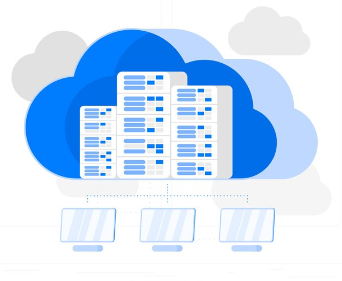Cloud Virtual Server
In the vast landscape of modern technology, the term “Cloud Virtual Server” often surfaces, capturing attention with its promises of flexibility and efficiency. But what exactly does it entail, and why is it so crucial in today’s digital era?
Understanding Cloud Computing
Cloud computing, the backbone of cloud virtual servers, revolutionizes how data is stored, processed, and accessed. Its essence lies in leveraging remote servers hosted on the internet to manage, store, and process data, rather than relying on local servers or personal devices.
The advantages of cloud computing are manifold, driving its widespread adoption across industries. Scalability reigns supreme, allowing businesses to effortlessly adjust computing resources based on demand fluctuations.
Cost-effectiveness follows suit, as cloud services typically operate on a pay-as-you-go model, eliminating the need for hefty upfront investments.
Additionally, flexibility reigns supreme, empowering users to access data and applications from any location with internet connectivity.
What is a Virtual Server?
At the heart of cloud computing lies the virtual server, a simulated environment created within a physical server, capable of running its own operating system and applications.
Unlike traditional physical servers, virtual servers share hardware resources but remain isolated from one another, offering unparalleled efficiency and versatility.
Virtual servers operate through hypervisor software, which divides physical servers into multiple virtual machines, each functioning independently. This abstraction layer enables efficient resource allocation and enhances security by isolating workloads.
The benefits of virtual servers extend beyond mere convenience. Resource optimization is a key advantage, as virtualization allows for the efficient allocation of computing resources, maximizing performance while minimizing waste.
Enhanced security is another boon, with each virtual server operating in isolation, shielding against potential breaches. Furthermore, easy scalability empowers businesses to swiftly adapt to changing needs without cumbersome hardware upgrades.
Cloud Virtual Server Basics
Embarking on a journey into cloud virtual servers necessitates a comprehensive understanding of its fundamental components. Cloud virtual servers come in various flavors, tailored to suit diverse needs and preferences.
Public cloud virtual servers, offered by third-party providers like Amazon Web Services (AWS) and Microsoft Azure, cater to the masses, delivering scalable computing resources on a shared infrastructure.
Private cloud virtual servers, in contrast, reside within a dedicated infrastructure, offering enhanced security and control at the expense of scalability.
Hybrid cloud virtual servers bridge the gap, combining the best of both worlds by integrating public and private cloud environments to meet specific business requirements.
Choosing the Right Cloud Virtual Server Provider
Selecting the optimal cloud virtual server provider is a pivotal decision that can significantly impact business operations. Several factors warrant consideration, ranging from performance and reliability to security and cost.
Performance emerges as a critical factor, influencing the speed and efficiency of operations. Reliability, on the other hand, encompasses uptime guarantees and disaster recovery capabilities, ensuring seamless continuity of services.
Security remains paramount, with robust measures safeguarding sensitive data from cyber threats and breaches. Cost considerations, while essential, should not overshadow the importance of quality service delivery.
Setting Up a Cloud Virtual Server
Setting up a cloud virtual server entails a systematic approach, beginning with the selection of a suitable provider and culminating in the deployment of applications.
Firstly, selecting a provider entails evaluating offerings based on performance, reliability, security, and cost. Once a provider is chosen, configuring server specifications and settings to align with business requirements is imperative.
Finally, deploying applications onto the virtual server marks the culmination of the setup process, paving the way for seamless operations.
Managing and Monitoring Your Cloud Virtual Server
Efficient management and monitoring are indispensable for optimizing the performance and security of cloud virtual servers. Leveraging appropriate tools and adhering to best practices can streamline operations and mitigate risks.
Control panels and monitoring software serve as indispensable aids, offering insights into server performance and health status. Embracing best practices, such as regular backups, security updates, and resource optimization techniques, fosters resilience and efficiency in server management.
Optimizing the Performance of Your Cloud Virtual Server
Performance optimization is a perpetual pursuit aimed at maximizing efficiency and responsiveness. Leveraging strategies like load balancing, caching, and Content Delivery Networks (CDNs) can alleviate bottlenecks and enhance user experience.
Load balancing distributes incoming traffic across multiple servers, preventing overload and ensuring smooth operations. Caching reduces latency by storing frequently accessed data closer to users, while CDNs accelerate content delivery by leveraging geographically distributed servers.
Ensuring the Security of Your Cloud Virtual Server
Security remains a paramount concern in the realm of cloud virtual servers, given the omnipresent threat landscape. Understanding common security threats and implementing robust measures is imperative for safeguarding sensitive data and maintaining trust.
Encryption, encompassing data encryption in transit and at rest, fortifies defenses against unauthorized access and interception. Access control mechanisms, including role-based access controls and multi-factor authentication, bolster security by limiting privileges and verifying user identities.
Regular audits and compliance assessments uphold accountability and ensure adherence to regulatory standards.
Scaling Your Cloud Virtual Server
Scalability lies at the core of cloud virtual servers, enabling businesses to expand or contract computing resources in response to changing demands.
Vertical scaling involves upgrading or downgrading server resources within a single instance, while horizontal scaling entails adding or removing instances to distribute workload efficiently.
Challenges and considerations abound in the scaling process, ranging from architectural complexities to cost implications. Nonetheless, judicious planning and implementation can surmount obstacles and unlock the full potential of cloud scalability.
Conclusion
In conclusion, cloud virtual servers epitomize the convergence of innovation and efficiency, reshaping the technological landscape and empowering businesses to thrive in an increasingly digital world.
From their inception in cloud computing to their pivotal role in driving performance, security, and scalability, cloud virtual servers represent a paradigm shift with far-reaching implications.
As we gaze into the future, the trajectory of cloud virtual servers appears boundless, poised to redefine industry standards and elevate the user experience to unprecedented heights.
By embracing the principles of adaptability, resilience, and innovation, businesses can harness the transformative power of cloud virtual servers and embark on a journey of sustained growth and success.






